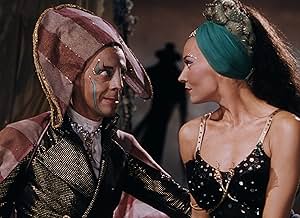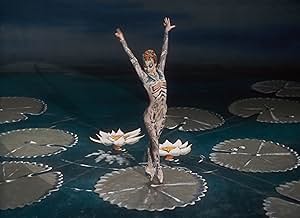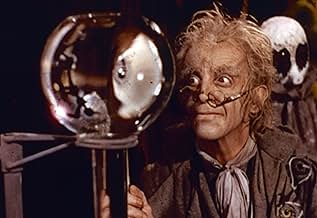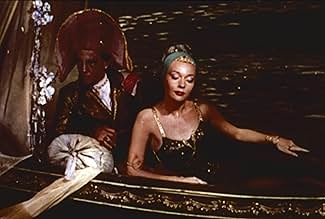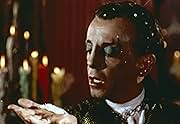Adicionar um enredo no seu idiomaA melancholy poet reflects on three women he loved and lost in the past: a mechanical performing doll, a Venetian courtesan, and the consumptive daughter of a celebrated composer.A melancholy poet reflects on three women he loved and lost in the past: a mechanical performing doll, a Venetian courtesan, and the consumptive daughter of a celebrated composer.A melancholy poet reflects on three women he loved and lost in the past: a mechanical performing doll, a Venetian courtesan, and the consumptive daughter of a celebrated composer.
- Direção
- Roteiristas
- Artistas
- Indicado a 2 Oscars
- 2 vitórias e 3 indicações no total
- Giulietta
- (as Ludmilla Tcherina)
- …
- Spalanzani
- (as Leonide Massine)
- …
- Olympia
- (canto)
- …
- Giulietta
- (canto)
- …
- Nicklaus
- (canto)
- …
- Spalanzani
- (canto)
- …
Avaliações em destaque
In "The Tales of Hoffmann", Robert Rounsevill stars as E.T.A. (Ernst Theodore Amadeus) Hoffmann, the poet and writer who tells three stories of his great but unhappy loves all ending tragically thanks to the meddling of his enemy, a supernatural villain (Robert Helpmann as quadruple evil, Lindorf, Coppelius, Dapertutto and Dr Miracle). Objects of Hoffmann's love and admiration include Olympia the wind-up doll (Moira Shearer who also plays Stella the dancer, the fourth and yet another Hoffmann's misadventure), Giulietta, the Venetian courtesan who sails away after trying to capture Hoffmann's soul (Ludmilla Tchérina -absolutely brilliant as the siren and the seductress who elegantly walks over the dead bodies, literally), and Antonia the beautiful opera-singer with the fatal voice and deadly illness. One of the greatest choreographers and dancers of the last century, Léonide Massine shines in three absolutely different roles demonstrating his talent as a dancer, strong emotions and tremendous humor.
What makes "The Tales of Hoffmann" not just an ordinary screen adaptation but the stunning unforgettable event, the film which had inspired the future famous directors George Romero and Martin Scorsese to become the filmmakers is the perfect combination of fantasy, classical music, ballet, singing, stunning visual effects, imaginative and often bizarre and even disturbing images that would fit a horror movie (deconstructing Olympia the doll is horrifying), incredible but calculated feast of colors, their mixture, the unique color palette to match each story, camera work that is so innovative and dynamic that even now, 56 years after the film was made, looks fresh and modern. The feast for eyes, ears, and feelings, "The Tales of Hoffmann" is the love child of incredibly talented people from different epochs and countries. The opera by Jacques Offenbach, the French composer is based on the dark romantic fairy tales by the German E.T. A. Hoffmann. The team of two directors known as "The Archers", the British Michael Powell and the Hungarian Jew Emeric Pressburger who had to flee his country before the WWII, and their international team of stars, color consultants, choreographers and production designers made this miracle happen. The last but not the least is legendary Sir Thomas Beecham conducting the Royal Philharmonic Orchestra.
On first viewing, my reaction to it was mixed: it's impossible not to be impressed by the visuals (particularly the stylization of Hein Heckroth's colorful and imaginative designs) but, since I'm no expert in classical music, I wasn't bowled over by Jacques Offenbach's score (apart from the celebrated "Barcarolle" piece) - especially since the lyrics, despite being an English translation, aren't easily followed! However, listening to it with the Audio Commentary, I could better appreciate the way it was made and the special effects that were adopted; especially interesting was the fact that it was filmed silent, thus allowing freer camera movement. The main cast, apart from Pamela Brown, is made up of ballet performers and opera singers - with the former, mostly recruits from THE RED SHOES, carrying the more compelling screen presence.
The framing story - featuring an additional ballet composed by the film's conductor Sir Thomas Beecham - is a bit short, so that we mostly learn about the characters played by Robert Rounseville (as Hoffmann) and Robert Helpmann through their various guises in the former's three tales (which are themselves variable in quality):
i) the "Olympia" sequence, highlighting Moira Shearer and Leonide Massine, is overlong but quite charming; Helpmann's distinctive features are rather buried under some quaint make-up - though his violent destruction of Shearer (who plays a doll) makes for a quite unsettling moment!
ii) "Giulietta" is the best and most interesting sequence, but also the shortest: Ludmilla Tcherina is a very sensuous heroine, while Helpmann and Massine are wonderful (and wonderfully made up) as respectively an evil magician and a (literally) soulless officer under both their spell; this sequence features some incredible imagery - like Tcherina's reflection in water picking up the aria she is singing, her walking over sculptures of dead bodies, Rounseville and Massine's saber duel set to music (i.e. presented without any sound effects) and the scene in which Rounseville loses his reflection when tempted in front of a mirror by Tcherina
iii) the "Antonia" sequence is again too long (it was severely cut in the original U.S. theatrical release) and, because it's mostly straight opera, emerges as the most labored segment: Massine is pretty much wasted here, while Ann Ayars is nowhere near as captivating as Shearer or Tcherina; however, Helpmann's belated entrance as the satanic Dr. Miracle takes the sequence to another level, and especially memorable here is the scene where Ayars exits a room only to re-enter it from another door (which must have inspired a similar incident in Mario Bava's KILL, BABY, KILL! [1966]) and the one where Ayars and Helpmann's dancing figures are divided into four to fill up the entire screen - with the latter taking each of his guises in the different segments and, likewise, the former being replaced with the heroines of each tale (Moira Shearer appears twice here as she also plays Stella, Hoffmann's love interest in the framing story!)
The Archers' films are among my favorites - though I was somewhat underwhelmed by I KNOW WHERE I'M GOING! (1945; I still haven't purchased the Criterion SE), THE BATTLE OF THE RIVER PLATE (1956; amazingly, both of my two attempts to view it in the past have only managed to put me to sleep!) and, now, THE TALES OF HOFFMANN. I've yet to watch 4 of their collaborations - CONTRABAND (1940; I've been tempted, time and again, to buy Kino's bare-bones DVD but the over-inflated price always got in the way!), THE ELUSIVE PIMPERNEL (1950), GONE TO EARTH (1950; this troubled production isn't likely to see the light of day on R1 DVD anytime soon, but is at least available via a budget-priced R2 edition), and their last 'musical' together OH, ROSALINDA! (1955). I would also like to watch Powell's solo films HONEYMOON (1959) and BLUEBEARD'S CASTLE (1964), which are yet two more musically-oriented ventures.
But the drawback is that only the tale of Olympia, the mechanical doll, and the ill-fated love affair with the young Hoffmann (played in all three segments by tenor Robert Rounseville) is up to the top standards the film strives to achieve. The other tales of Hoffmann's follies are less interesting, not as easy to understand and not as entertaining or melodious as the Olympia segment.
The final tale of Antonia suffers from the high notes forced upon screeching soprano (Anne Ayars) and the demands of the score which is clearly more tedious than melodious at this point.
Robert Helpmann as the villain in all three tales is excellent and Robert Rounseville as Hoffmann is the only cast member who does his own singing in a strong tenor voice. You may remember him as Mr. Snow in Rodgers and Hammerstein's "Carousel" with Gordon MacRae and Shirley Jones.
But there's no denying the magic of all the visual images on screen which includes the use of puppets and a good mixture of cinema and stage techniques. Opera lovers will find fault with some of the singers but it's hard to see any fault in the dancing which looked magnificent to me.
None of the stories are as involving as "The Red Shoes" and this is one of the weaknesses of the film. The first story is far better than the rest of the tales which makes for an uneven blend of storytelling.
A brilliant use of color and classical music makes it a "must see" for most film buffs.
Você sabia?
- CuriosidadesGeorge A. Romero, writer/director of A Noite dos Mortos-Vivos (1968) and Zombie - O Despertar dos Mortos (1978) has cited this as his all-time favorite movie, saying that it was the one that originally inspired him to get into filmmaking.
- Erros de gravaçãoGiulietta's necklace is turned from jewels to wax by Dapertutto, however, in a longer shot, it is briefly shown as jewels again, before a close-up, where it is wax again until Dapertutto changes it back to jewels.
- Citações
Chorus of Students: Some drink, drink, drink, drink, drink: do you hear us about? You lazy lout! We want some beer; we want some wine! Pour out the wine, and drink and drink till morning. Pour out the wine for drinking is divine. It is divine. We want some beer; we want some wine. We want some beer; we want some wine.
- Cenas durante ou pós-créditosIn the end credits, main actors appear taking curtain calls next to the singers who dubbed them.
- Versões alternativasThe complete 138-minute version was available in 16mm black and white early television prints. The complete 138-minute version was also available in 16mm Kodachrome (color) rental prints. The complete 138-minute soundtrack was available for many years on LP (London Records).
- ConexõesFeatured in The Late Show: Michael Powell (1992)
- Trilhas sonorasThe Tales of Hoffmann, A Fantastic Opera
Music by Jacques Offenbach
Arranged by Thomas Beecham (uncredited)
English libretto by Dennis Arundell
From the French text by Jules Barbier
Conductor: Thomas Beecham (as Sir Thomas Beecham Bart.) with The Royal Philharmonic Orchestra
Sung by Robert Rounseville, Dorothy Bond, Margherita Grandi, Ann Ayars (as Ann Ayars), Monica Sinclair, Joan Alexander, Grahame Clifford, Bruce Dargavel, Murray Dickie, Owen Brannigan, Fisher Morgan, Rene Soames, and The Sadler's Wells Chorus
Principais escolhas
Detalhes
- Data de lançamento
- País de origem
- Idioma
- Também conhecido como
- Contos de Hoffman
- Locações de filme
- Empresas de produção
- Consulte mais créditos da empresa na IMDbPro
Bilheteria
- Faturamento bruto nos EUA e Canadá
- US$ 91.930
- Fim de semana de estreia nos EUA e Canadá
- US$ 23.340
- 15 de mar. de 2015
- Faturamento bruto mundial
- US$ 140.714
- Tempo de duração2 horas 13 minutos
- Proporção
- 1.37 : 1
Contribua para esta página




